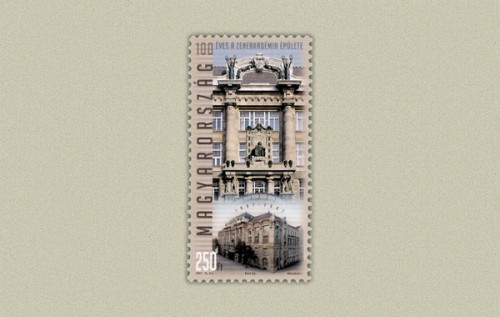
1. MAGYAR - 100 ÉVES A ZENEAKADÉMIA ÉPÜLETE - Bélyeg rendelési kód: 2007 év bélyegei kompletten
2. ENGLISH - BUILDING OF THE ACADEMY OF MUSIC IS 100 YEARS OLD - Order code of the stamp: 2007 Year stamps complete
3. GERMAN - 100 Jahre der Akademie der Musik-Gebäude - Marke die sprechstunde kode: 2007 Jahr Briefmarken komplett
1. MAGYAR - 100 ÉVES A ZENEAKADÉMIA ÉPÜLETE
A Magyar Posta alkalmi bélyeget bocsát ki a Zeneakadémia épületének 100. évfordulója tiszteletére.
A Zeneakadémia alapításának ötlete 1869-ben merült fel. A magyar parlament 1873-ban szavazta meg az intézmény felállításának költségeit, bár az eredetileg tervezetthez képest jóval szerényebb keretek között.
1875 márciusában Liszt Ferencet nevezték ki a Zeneakadémia elnökévé, amely az év október 14-én nyitotta meg kapuit. Az intézmény igazgatója Erkel Ferenc lett. A Zeneakadémia első otthona egy bérház volt a Duna-parton, később egy Sugár úti (mai Andrássy út) épületbe költözött. Végül 1907. május 12-én nyílt meg az a szecessziós épület, ami ma már a Zeneakadémia - Liszt Ferenc Zeneművészeti Egyetem intézménynek ad otthont.
A Giergl Kálmán és Korb Flóris tervei alapján épült a 2600 nm-es palota. Belépve a színes és gazdag ornamentikájú előcsarnokba jutunk, amelynek tompított világítása is a szentélyek hangulatát idézi. A koncerttermek közül a Nagyterem a korai hazai vasbeton építészet kitűnő alkotása. Koncertterme több mint 1200 hallgató befogadásra alkalmas, a szerényebb kiképzésű Kisteremben 400 ember élvezheti a zenei előadásokat.
Liszt Ferenc (Franz Liszt) (1811–1886) a 19. század egyik legjelentősebb romantikus zenésze, minden idők egyik legnagyobb zongoraművésze. 1875-ben alakult Zeneakadémia egyik alapítója és első tanára is egyidejűleg. A róla elnevezett Liszt Ferenc Zeneművészeti Egyetem ma is világhírű zeneoktatási intézmény.
A bélyegképen lent a Zeneakadémia épülete, felette az épület egyik jellegzetes részlete, a homlokzat látható. Az alkalmi borítékot az épület pompázatos belső terének néhány eleme díszíti: az előtér Zichy István magyaros témájú freskójával, a koncertterem az orgonával a háttérben és Kőrösfői-Krisch Aladár: A művészetek forrása című faliképe. Az alkalmi bélyegzőn a névadó Liszt Ferenc látható.
Megjelenési időpont: 2007. május 18.
Forrás: Philatelia Hungarica Kft., Magyar Posta
2. ENGLISH - BUILDING OF THE ACADEMY OF MUSIC IS 100 YEARS OLD
Magyar Posta is issuing a commemorative stamp in honour of the centenary of the building of the Academy of Music.
The idea of founding the Academy of Music first arose in 1869. The Hungarian parlia-ment approved the costs of establishing the institution in 1873, albeit a far more modest version of the original plan.
In March 1875 Franz Liszt was appointed president of the Academy of Music and it opened its gates on 14 October the same year. Ferenc Erkel became the director of the Academy.
The Academy’s first home was in an apartment block on the Danube embankment and it later moved to a building in Sugár Avenue (now Andrássy Avenue). Finally, it moved on 12 May 1907 to the Art Nouveau building which is today the home of the Academy of Music – the Franz Liszt University of Music.
The 2,600 m2 building was designed by Kálmán Giergl and Flóris Korb. The foyer is colourfully and richly decorated, and the subdued lighting contributes to the feeling of reverence.
The main concert hall is a fine example of early reinforced concrete construc-tion in Hungary and can seat over 1,200 people, while the performances in the more modestly finished small hall can be enjoyed by an audience of 400 people.
Franz Liszt (1811–86) was a major 19th-century Romantic composer and one of the greatest pianists of all time. He was a founder of the Academy of Music in 1875 and also its first teacher.
The Franz Liszt University of Music named after him continues to have a strong international reputation today. In the lower half of the stamp design is the building of the Academy, while its well-known façade is shown in the upper half. A few aspects of its splendid interior adorn the first day cover: the foyer with István Zichy’s fresco with a Hungarian subject, the concert hall with the organ in the background and Aladár Kőrösfői-Krisch’s mural “The Source of the Arts”.
The postmark depicts Franz Liszt, whose name the building bears. Sources: www.vendegvaro.hu; www.wikipedia.org; www.zeneakademia.hu
Date of issue: 18 May 2007
3. GERMAN - 100 Jahre der Akademie der Musik-Gebäude
Die Ungarische Post ausgestellten Briefmarken gelegentlich Gebäude der Hochschule für Musik 100. Jubiläum.
Die Academy of Music in 1869, Gründungsidee angesprochen wurde. Das ungarische Parlament hat im Jahr 1873, der institutionelle Aufbau der Kosten, wenngleich viel bescheidener als ursprünglich geplanten Rahmen.
Im März 1875 wurde er an der Franz-Liszt-Musikakademie Präsidenten des Jahres am 14. Oktober bestellt ihre Türen geöffnet. Ferenc Erkel lettische Regisseur des Organs. Die Akademie der Musik, wurde zum ersten Mal zu Hause ein Mietshaus an der Donau, reisen dann einen Radius von (heutigen Andrássy út) wurde auf dem Gebäude. Schließlich 1907. Am 12. Mai öffnete das Jugendstil-Gebäude, das heute der Hochschule für Musik - Ferenc Liszt Academy of Music wird Institution Gastgeber.
Der Korb und Kálmán Giergl Flóris gebaut Plänen des 2600-nm-Palast. Einreise in die Halle, ornamentikájú wir bunt und reich, mit Abblendlicht auch beschwört die Atmosphäre der Heiligtümer. Der Konzertsaal der Großen Halle des ersten Heim-Architektur, ausgezeichnete konkrete Arbeit. Der Konzertsaal mit mehr als 1.200 Studenten für die Zulassung, kann die weniger ausgebildeten Kisteremben 400 Menschen genießen die musikalischen Darbietungen.
Ferenc Liszt (Franz Liszt) (1811-1886) 19 Jahrhundert, eines der romantischsten Musiker, einer der größten Pianisten aller Zeiten. Academy of Music wurde 1875 von dem Gründer und ersten Lehrer zur gleichen Zeit auch gegründet. Das Franz Liszt-Hochschule für Musik nach ihm benannte nun weltberühmte Musik Bildungseinrichtung umfassen.
Der Stempel unter der Hochschule für Musik Gebäude, kann das Gebäude über ein typisches Detail der Fassade zu sehen. Die gelegentliche Hülle des Gebäudes ist mit luxuriösen Interieurs dekoriert, einige Elemente: Die Front ist freskójával ungarischen Istvan Zichy, Konzertsaal-Orgel in den Hintergrund und Körösföi-Aladar Krisch: Die Kunst auf dem Quell-Wand. Die gelegentliche Stempel der gleichnamigen Liszt sichtbar.










